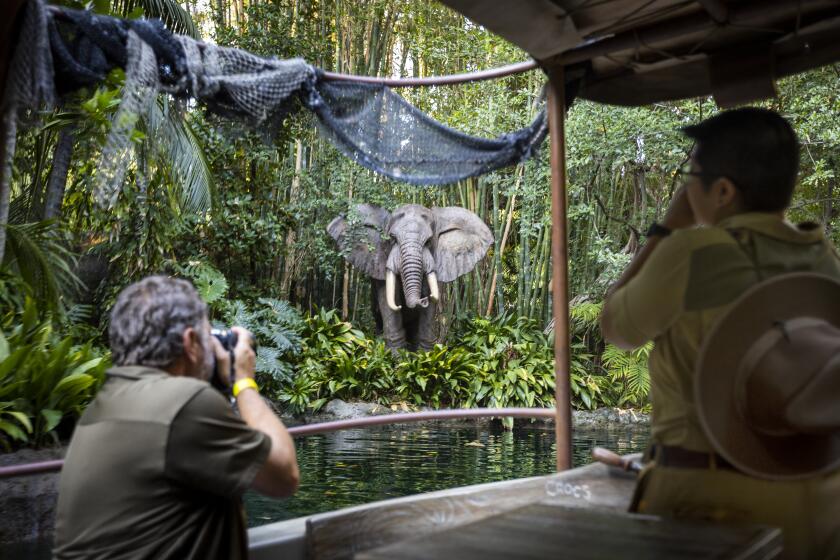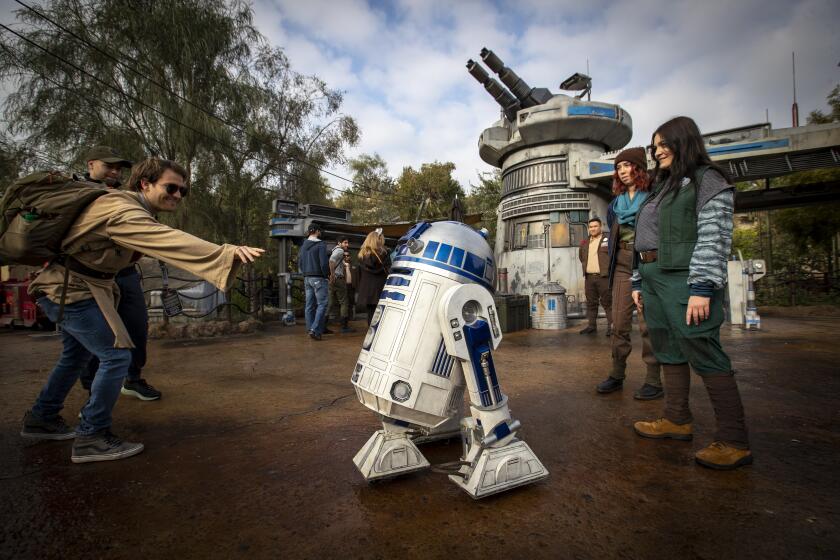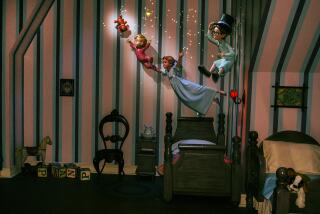Disneyland to make the Jungle Cruise more inclusive after years-long complaints of racism
Disneyland’s Jungle Cruise has set sail in the park’s Adventureland area consistently since 1955, and it stands today as one of the remaining opening day attractions overseen by Walt Disney himself.
But culture often moves faster than decades-old mechanical hippos.
On Monday, the Walt Disney Co. announced that it’s embarking on what many view as a long-overdue course correction for the Jungle Cruise. Numerous changes will make the attraction feel more inclusive and less racially insensitive in its depiction of other cultures.
The move follows updates to other older attractions such as Splash Mountain and Pirates of the Caribbean, all done to remove now-outdated tableaus that can be cringe-inducing at best and racist at worst. The company had already announced that Splash Mountain, originally inspired by the critters in the racist film “Song of the South,” would receive a makeover themed to “The Princess and the Frog,” the movie that featured Disney’s first Black princess.
Skippers at the newly updated Jungle Cruise ride at Disneyland entertained some park attendees Friday while on a first look journey.
The Jungle Cruise, with its ties to the park’s patriarch, is likely to be viewed with a more protective lens by the company’s vast fanbase. Yet the ride has also been one under near-constant evolution since its inception. Its early influences were Disney’s own nature documentaries and the 1951 film “The African Queen,” a favorite of early Disneyland designer Harper Goff.
Its initial conception as “The Jungle Rivers of the World” leaned slightly more educational than today’s more humor-driven take. The ride’s unsavory tribal depictions, largely inspired by images from Papua New Guinea, were added in the years after its opening. These vignettes essentially depict Indigenous people as tourist attraction, attackers or cannibals.
“Horrifyingly racist” is how one of Disney’s peers in the theme park design community, the Thinkwell Group, characterized various Jungle Cruise scenes in an essay published shortly after Disney announced the changes to Splash Mountain.
A spear-waving war party was added to the Jungle Cruise in 1957, as was the “Trader Sam” character, a dark-skinned man today outfitted in straw tribal wear. Disney tiki bars — one on each coast — are named for the character that traffics in stereotypes. He’ll trade you “two of his heads for one of yours.”
“As Imagineers, it is our responsibility to ensure experiences we create and stories we share reflect the voices and perspectives of the world around us,” Carmen Smith said in a statement provided by Disney. Smith is the creative development and inclusion strategies executive at Walt Disney Imagineering, the company’s division responsible for theme park experiences.
Concept art previewed by Disney showed a reworking of the “trapped safari” scene, in which adventurers scurry up a tree to avoid the horn of a rhinoceros. In its current state at Disneyland, a white traveler is at top while native safari guides are in a more perilous position. The reimagined scene, one initially dreamed up by master Disney animator-designer Marc Davis as an advertisement for the ride, solely features hapless participants of a previous Jungle Cruise boat tour.
Changes, Disney stressed, are being made independent of an upcoming Jungle Cruise-inspired film starring Dwayne Johnson and Emily Blunt. Expect all scenes that feature unsavory depictions of Indigenous characters to be updated, said a Disney spokesperson, although details on potential tweaks to the war party scene and the Trader Sam finale have not yet been shared.
As silly and overly pun-filled as the Jungle Cruise may be, it has long been criticized as viewing adventure through an imperialist lens. Non-Americans are depicted as either subservient or savages. Although the ride is meant to be a collage of Asia, Africa and South America, human figures of the regions are presented as exotic, violent and dimwitted, humor that in the 1950s and 1960s was troublesome and today reeks of racism.
It’s also a point of view that clashes with the broader cultural Disney theme park mission, which over the decades has shifted from cartoonish and simplistic depictions of other cultures to a brand with a more global perspective. When Walt Disney World opened Animal Kingdom in 1998, Africa and Asia were shown in a more revered light, which only served to heighten the outdated cultural depictions of the Jungle Cruise.
COVID led Disneyland to cancel its annual pass program. Why locals matter to theme park survival and what Disney should and shouldn’t do when it revamps the program.
Disney expects the changes to be completed this year at both Disneyland and Florida’s Walt Disney World, where the ride is currently open. The company adds that timelines could be affected by the COVID-19 pandemic, which led to Disneyland’s closure nearly a year ago. Even with Gov. Gavin Newsom’s lifting of stay-at-home orders this week, Disneyland may remain closed for some time.
As part of the changes, the story of the attraction will be tweaked. Guests will follow the exploits of a Jungle Cruise tour gone awry and throughout the ride catch glimpses of this past expedition. Expect, for instance, to see an old Jungle Cruise boat overtaken by chimpanzees, as the new scenes are designed to add fresh life, activity and characters to the attraction, while also fueling more corny jokes from the ride’s tour guides.
“When we consider making changes to a classic attraction, we focus on ways to ‘plus’ the experience,” said Chris Beatty, creative executive at Walt Disney Imagineering. “The skippers of the Jungle Cruise bring irreverent humor to guests of all ages, and we’re excited to be adding to that legacy — along with a new animated skipper figure — by celebrating their adventures and influence.”
Although the ride has long featured nods to past excursions that ended poorly, Disney is planning to add figures that will represent other tourists and, as Beatty noted, a not-so accomplished skipper. This move will help accomplish Disney’s goal of removing tribal caricatures and, in the words of Disney, “negative depictions of native people.”
“For the first time ever, the skipper role will not only be that of a live, experienced and witty guide, but also represented by a show figure within the attraction itself,” said Kevin Lively, a story editor with Walt Disney Imagineering.
Disney announced a new theme based on “The Princess and the Frog” for Splash Mountain, long criticized for its association with the racist film “Song of the South.”
To those who follow the parks, the changes shouldn’t be entirely unexpected, especially with a movie starring Johnson and Blunt destined for theatrical distribution. “The Jungle Cruise,” like many other films affected by pandemic-related closures, was postponed from its 2020 release date to one this summer.
Worth noting, however, is that in this instance, Disney is not waiting to see how audiences respond to the picture. Consider it an indication that Disney is aware that the ride’s cultural makeover is a necessity more urgent than what marketing calendars may allow. Additionally, a Disney spokesperson says the new figures will not represent characters in the film.
None of the amended scenes were in the Jungle Cruise on Disneyland’s July 1955 opening, although that ride would look vastly different to today’s audiences.
Animals were then scarce — just seven hippos and eight crocodiles were present in the water, according to documentation of the park’s opening year — and the vast vegetation had not yet grown to mask nearby buildings. Many of the ride’s most beloved scenes, such as the elaborate elephant bathing pool, were dreamed up by animator-turned-Imagineer Davis and added in the 1960s.
Longtime fans of the attraction can expect to see some nods to retired boats in the new scenes, but the goal is a more inclusive ride that doubles down on silliness. Says Lively, “Ultimately, the jungle gets the last laugh.”
More to Read
The biggest entertainment stories
Get our big stories about Hollywood, film, television, music, arts, culture and more right in your inbox as soon as they publish.
You may occasionally receive promotional content from the Los Angeles Times.













